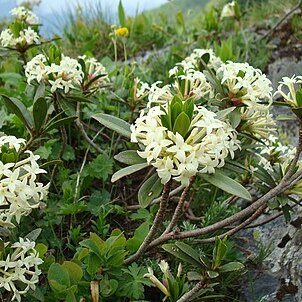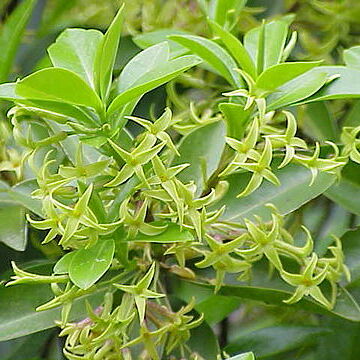Shrubs or subshrubs, evergreen or deciduous. Branches glabrous or pubescent. Leaves mostly alternate, sometimes opposite; petiole short. Inflorescence usually terminal, sometimes axillary, capitate or shortly racemose, sometimes paniculate, racemose, or spicate, with or without involucre; peduncle short or absent. Flowers bisexual or unisexual (plants sometimes dioecious), 4-or 5-merous. Calyx tube white, pink, or yellow, rarely mauve, campanulate, cylindric, or slightly funnel-shaped, exterior glabrous or pubescent; lobes 4 or 5, erect or spreading, alternately longer and shorter. Petaloid appendages absent. Stamens twice as many as calyx lobes, in two series; filaments short or absent; anthers oblong, included; connectives indistinct. Disk absent or annular, cup-shaped, sometimes elongated on one side. Ovary usually sessile or slightly stipitate, ovoid, 1-loculed; style terminal, short; stigma capitate. Fruit a succulent berry or dry and leathery, sometimes enclosed by persistent calyx, sometimes naked, usually red or yellow. Seed testa crustaceous, endosperm scanty or absent; cotyledons fleshy.
Shrubs, deciduous or evergreen, to 1.5 m. Stems erect, procumbent, or prostrate, branched, not jointed, thick, glabrous or glabrescent. Leaves clustered distally, sessile or subsessile; blade obovate or oblong to lanceolate, surfaces glabrous or hairy. Inflorescences terminal or axillary, capitate, fasciculate, or racemose, flowers sessile [petiolate]; bracts 0. Flowers: hypanthium tubular to narrowly funnelform; calyx 4-lobed, lobes spreading or slightly reflexed; petals absent; stamens 8, usually included, in distal 1/2 of tube; style included, short or absent; stigma capitate. Fruits drupaceous, yellow, red, or black, fleshy, hypanthium not persistent.
Prostrate to medium-sized, deciduous or evergreen shrubs with very tough fibrous bark. Lvs usually alternate, rarely opposite, entire, often clustered at branch ends; petiole short. Fls usually in small heads or clusters, sometimes subtended by an involucre, ☿, usually fragrant. Calyx petaloid, 4-lobed; tube often swollen at base. Petals 0. Stamens 8, in 2 rows, included or slightly exserted, inserted on calyx tube. Style short or almost 0; stigma capitate. Ovary 1-locular. Fr. a drupe, usually fleshy, rarely coriaceous.
Evergreen or deciduous, erect to prostrate shrubs (or small trees). Leaves alternate, rarely opposite. Flowers in clusters in terminal or axillary heads or racemes, perianth with 4 lobes on a cylindrical tube, mostly fragrant, white or yellow to lilac, purple or pink. Stamens 8 in 2 whorls of 4. Ovary 1-celled. Style short or absent. Fruit a coriaceous or fleshy 1-seeded drupe.
Fls perfect; hypanthium tubular, not constricted above the ovary, bearing 8 short included stamens near the middle; sep 4, spreading, petaloid; pet none; style very short, with a large, capitate stigma; fr a drupe; shrubs with conspicuous fls in axillary or terminal clusters. 70, Old World.


